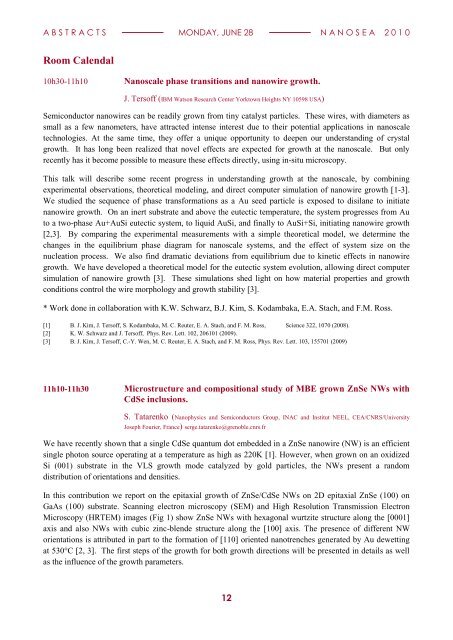book of abstracts - IM2NP
book of abstracts - IM2NP
book of abstracts - IM2NP
You also want an ePaper? Increase the reach of your titles
YUMPU automatically turns print PDFs into web optimized ePapers that Google loves.
A B S T R A C T S MONDAY, JUNE 28 N A N O S E A 2 0 1 0<br />
Room Calendal<br />
10h30-11h10<br />
Nanoscale phase transitions and nanowire growth.<br />
J. Ters<strong>of</strong>f (IBM Watson Research Center Yorktown Heights NY 10598 USA)<br />
Semiconductor nanowires can be readily grown from tiny catalyst particles. These wires, with diameters as<br />
small as a few nanometers, have attracted intense interest due to their potential applications in nanoscale<br />
technologies. At the same time, they <strong>of</strong>fer a unique opportunity to deepen our understanding <strong>of</strong> crystal<br />
growth. It has long been realized that novel effects are expected for growth at the nanoscale. But only<br />
recently has it become possible to measure these effects directly, using in-situ microscopy.<br />
This talk will describe some recent progress in understanding growth at the nanoscale, by combining<br />
experimental observations, theoretical modeling, and direct computer simulation <strong>of</strong> nanowire growth [1-3].<br />
We studied the sequence <strong>of</strong> phase transformations as a Au seed particle is exposed to disilane to initiate<br />
nanowire growth. On an inert substrate and above the eutectic temperature, the system progresses from Au<br />
to a two-phase Au+AuSi eutectic system, to liquid AuSi, and finally to AuSi+Si, initiating nanowire growth<br />
[2,3]. By comparing the experimental measurements with a simple theoretical model, we determine the<br />
changes in the equilibrium phase diagram for nanoscale systems, and the effect <strong>of</strong> system size on the<br />
nucleation process. We also find dramatic deviations from equilibrium due to kinetic effects in nanowire<br />
growth. We have developed a theoretical model for the eutectic system evolution, allowing direct computer<br />
simulation <strong>of</strong> nanowire growth [3]. These simulations shed light on how material properties and growth<br />
conditions control the wire morphology and growth stability [3].<br />
* Work done in collaboration with K.W. Schwarz, B.J. Kim, S. Kodambaka, E.A. Stach, and F.M. Ross.<br />
[1] B. J. Kim, J. Ters<strong>of</strong>f, S. Kodambaka, M. C. Reuter, E. A. Stach, and F. M. Ross, Science 322, 1070 (2008).<br />
[2] K. W. Schwarz and J. Ters<strong>of</strong>f, Phys. Rev. Lett. 102, 206101 (2009).<br />
[3] B. J. Kim, J. Ters<strong>of</strong>f, C.-Y. Wen, M. C. Reuter, E. A. Stach, and F. M. Ross, Phys. Rev. Lett. 103, 155701 (2009)<br />
11h10-11h30<br />
Microstructure and compositional study <strong>of</strong> MBE grown ZnSe NWs with<br />
CdSe inclusions.<br />
S. Tatarenko (Nanophysics and Semiconductors Group, INAC and Institut NEEL, CEA/CNRS/University<br />
Joseph Fourier, France) serge.tatarenko@grenoble.cnrs.fr<br />
We have recently shown that a single CdSe quantum dot embedded in a ZnSe nanowire (NW) is an efficient<br />
single photon source operating at a temperature as high as 220K [1]. However, when grown on an oxidized<br />
Si (001) substrate in the VLS growth mode catalyzed by gold particles, the NWs present a random<br />
distribution <strong>of</strong> orientations and densities.<br />
In this contribution we report on the epitaxial growth <strong>of</strong> ZnSe/CdSe NWs on 2D epitaxial ZnSe (100) on<br />
GaAs (100) substrate. Scanning electron microscopy (SEM) and High Resolution Transmission Electron<br />
Microscopy (HRTEM) images (Fig 1) show ZnSe NWs with hexagonal wurtzite structure along the [0001]<br />
axis and also NWs with cubic zinc-blende structure along the [100] axis. The presence <strong>of</strong> different NW<br />
orientations is attributed in part to the formation <strong>of</strong> [110] oriented nanotrenches generated by Au dewetting<br />
at 530°C [2, 3]. The first steps <strong>of</strong> the growth for both growth directions will be presented in details as well<br />
as the influence <strong>of</strong> the growth parameters.<br />
12

















